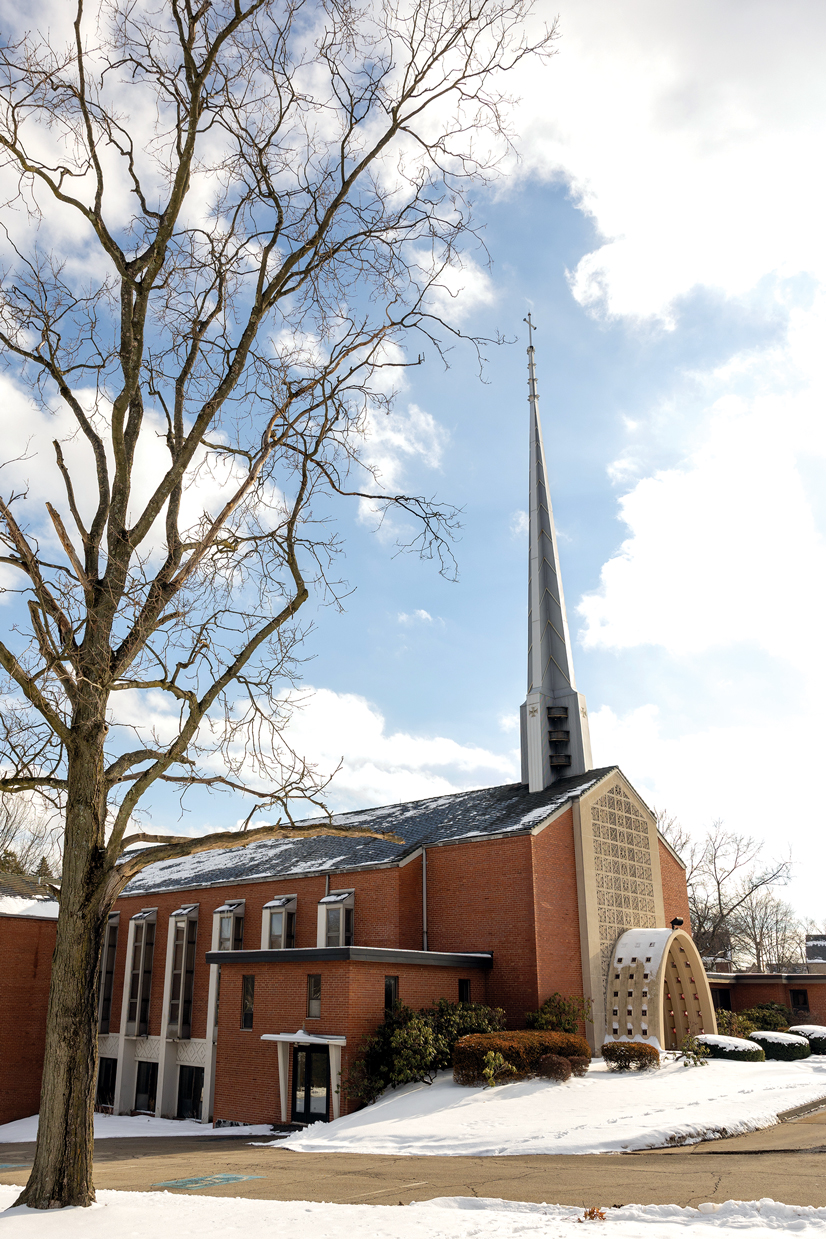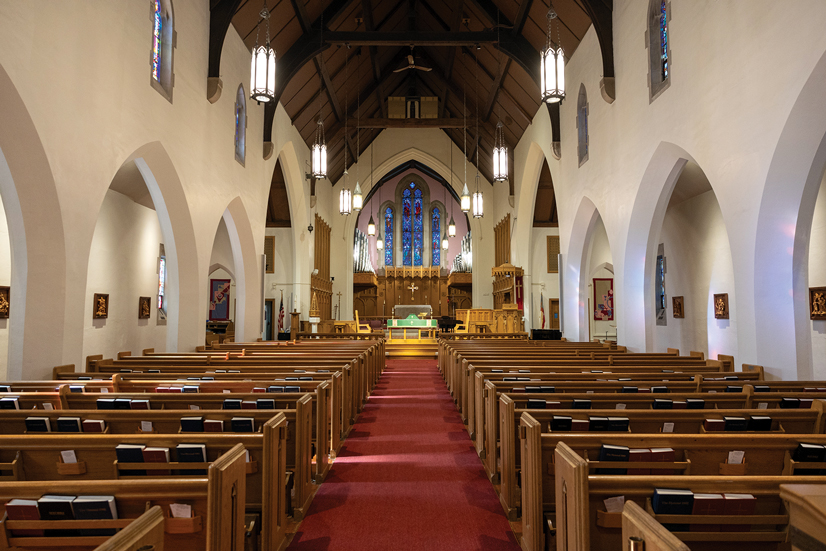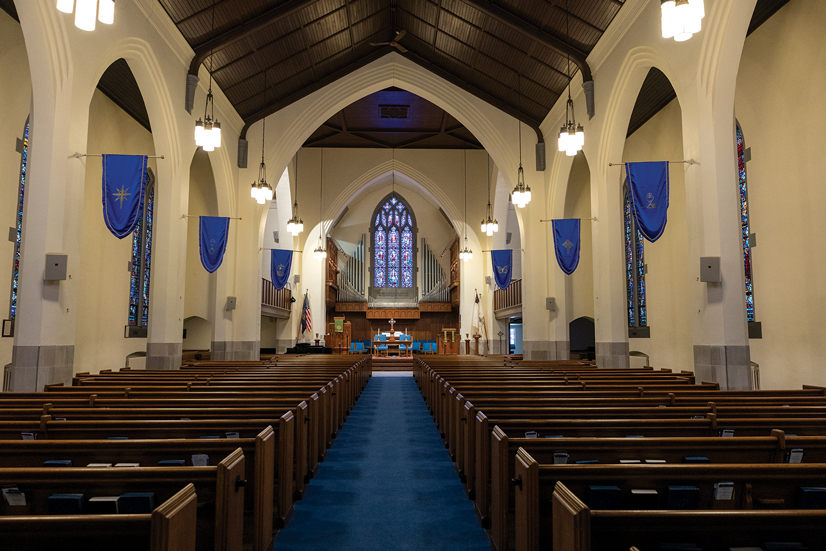Churches Celebrate Centennials

One hundred years ago, Mt. Lebanon was a small community that had split off from Scott Township just over a decade earlier in 1912. With 2,000+ souls and a smattering of houses, most of the area was still semi-rural.
And yet, within six months in 1924-25, three separate groups of people of faith moved to establish new churches within its borders: Episcopal, Presbyterian and Lutheran. Those three churches, along with the previously established Mt. Lebanon United Presbyterian Church, have endured, anchoring Lebo’s main road in the ensuing 100 years.
Escaping the City
The long-anticipated Liberty Tunnels opened in 1924, offering a quicker route from the smoke of downtown steel mills to the South Hills. The Liberty Bridge opened in 1928 and made the trip to Mt. Lebanon, Dormont and other new communities south of the city much easier. This sparked new development and growth.
Between 1920 and 1930, the population in Mt. Lebanon grew 500 percent — from 2,258 to 13,403. “Mt. Lebanon went from being a streetcar suburb to an automobile suburb in that decade,” said Geoff Hurd, former president of the Historical Society of Mount Lebanon. “As soon as the tunnels and bridge opened, there was a direct route to the South Hills, where there was fresh air and land to build on. And it was an invitation to cars.”
Residents wanted houses of worship to serve people moving into developments like Mission Hills, which were springing up on either side of centrally located Washington Road.
On Sunday, December 21, 1924, the new St. Paul’s Episcopal congregation held its inaugural service at Washington Elementary School. Originally founded around 1835 in Lacyville, a neighborhood of Pittsburgh now part of the Hill District. St. Paul’s got a new start in Mt. Lebanon under the same charter, although there is no record of any members moving with the church; it was simply a movement of assets.
Weeks later, in January 1925, 25 people met to worship in Washington Elementary School and form the Mt. Lebanon United Lutheran Church congregation. “It was a growing area,” according to the church’s senior pastor, Rev. Douglas Heagy. “The church always tried to be out ahead of the migration of population.”
And on April 26, 1925, 183 charter members founded the new Mt. Lebanon Presbyterian Church. The young congregation had begun worshipping informally at Washington Elementary School the previous November. The only established church in Mt. Lebanon was the similarly named Mt. Lebanon United Presbyterian Church (now Mt. Lebanon Evangelical Presbyterian Church) on the corner of Scott and Washington roads. However, the Presbyterian and United Presbyterian denominations were completely separate entities until they combined in 1958. It was then that Mt. Lebanon Presbyterian changed its name to Southminster to avoid confusion.
Within the next few years, each of these new congregations constructed sanctuary buildings: the Lutherans on the corner of Academy Avenue and Washington Road; Southminster at 799 Washington Road at Castle Shannon Boulevard in 1928; and St. Paul’s at 1066 Washington on the corner of Mayfair Drive in 1930. The latter two buildings were subsequently enlarged as membership grew. Facing the same problem, Mt. Lebanon United Lutheran Church sold its building and built a new one in 1955 at 975 Washington Road.
All three congregations grew rapidly along with Mt. Lebanon’s population through the 1930s and ’40s. Then in the postwar period of the late 1940s and 1950s, the suburbs exploded when the GIs came home and started families, resulting in the Baby Boomer generation that filled houses, schools and churches well into the ’70s.
According to Rev. Noah Evans, rector of St. Paul’s, at one point in the 1960s there was an article in Life magazine about St. Paul’s, which was the fastest-growing Episcopal congregation in the nation. It is still the largest church in the Episcopal diocese of Pittsburgh.

Churches Face Challenges
No organization grows without overcoming challenges, and these congregations are no exception.
“The church took out a mortgage in 1928, then the Depression hit,” according to Fred Barnes, pastoral care associate at Southminster. “It must have been very difficult.”
Mt. Lebanon United Lutheran not only had financial difficulties because of the Depression, but its first pastor died suddenly a year after his installation. “I recently led a study group at church where we went through our history, decade by decade,” said Heagy. “Participants were greatly moved by the stories they encountered: stories of struggles, vision, financial issues, all the effort from people who sustained the church through good times and bad.”
There have also been many cultural changes to deal with. “As society has changed, we’ve wrestled with and discussed these changes,” Barnes said. “In the ‘50s, it was the ordination of women. In the ‘60s, civil rights. In the ‘70s, the war in Vietnam. In the ‘80s, AIDS, and the ‘90s, LGBTQ rights. Then there’s climate change more recently.”
Other changes include competing activities, such as sports, on Sunday mornings, and two-earner households, leaving families with a shortage of free time.
Mt. Lebanon United Lutheran plans to honor the women of the past century. “We want to shine a light on the role of women in the past life of the church,“ said Heagy. “It’s evident they were denied leadership roles in the congregation for decades. Yet behind the scenes there were countless women working in service.”
“The mission of the church doesn’t change, but the vision does,” said Rev. Doug Marshall, interim senior pastor of Southminster, “depending on what’s going on in the world and the community. We have to figure out what we are being called to do with God.”

The Value of Centennials
A century later, these churches are celebrating their pasts while looking forward to their second hundred years.
“It’s always good to know your roots and where you came from,” Heagy said. “But it’s also important to mark our centennial, because it’s a good time to look forward and see where God might be leading us. We began small and tiny, and people were willing to take the risk to borrow money to build the building. If people could do that in 1925, stepping out in faith, it gives encouragement to everybody today to look forward to what might be possible.”
Marshall concurs. “This is a hard world we live in, so any time you get a reason to celebrate, it’s worthwhile. A lot of churches don’t make it to 100 years. We want to rejoice in the history of what we’ve done and celebrate what God is wanting us to do in the future.”
“Our centennial is important to launch the legacy we’ve had in serving this community for 100 years,” said Evans. “St. Paul’s is always opening its doors to reach out and serve the community around us. That’s a legacy that continues today.”
Reaching Those in Need
As churches have navigated new issues, they continue to reach out to communities in need. “At the heart of St. Paul’s has always been the gathering of people into community in order to serve,” Evans said. “That’s a pattern we’ve seen over the last century. That’s a legacy that continues today. Interfaith connection is a passion of this congregation, reaching out across differences.”
That has included his congregation’s outreach to the Turkish immigrant community. Another project is partnering with the Episcopal Diocese to take charge of the Church of the Advent, a now-closed Episcopal church in Brookline. “That’s a community with a more diverse demographic, where we can reach out and support new immigrants in that area and other people in need.”
Southminster runs a food pantry out of its manse, a center for older adults, and a lending service for medical equipment. Barnes said Southminster has also joined with other organizations to make a difference. “I think we will continue to be a hands-on church, partnering with other organizations like the Urban League of Pittsburgh.”
“I have seen our church become more focused on being actively involved on a personal level in local and regional mission work,” said Carol Walton, Lancaster Avenue, who heads the anniversary committee at Southminster. “It used to be that it was ‘Send your money to such-and-such a missionary or the national church.’ Now we have a food pantry and volunteer groups that do work in the Pittsburgh area.”
Mt. Lebanon United Lutheran is serving newly arrived immigrants from places like Nepal and Afghanistan with supplies, clothing and English classes at the church. “We work with local refugee and immigrant communities,” said Alan Trivilino, Roycroft Avenue, chair of the 100-year celebration committee. “We also collect medical supplies to send around the world to help others.”
Another church group, the Daily Bread Outreach, goes to the North Side to help ease food and housing insecurity. Mt. Lebanon Lutheran also partners with local organizations such as SHIM (South Hills Interfaith Movement), a food pantry and social services resource.

Celebration Events
All three churches plan to mark their 100th anniversaries with events throughout the year. St. Paul’s held a service in December at Washington Elementary School, on the exact day and place it all began a century ago. The church will also kick off a capital campaign to restore and stabilize its building and a number of events commemorating its century of existence in town.
“There are a number of people who grew up at Southminster who went on to become pastors themselves, so we’re inviting them back, one a month, through 2025,” said Walton. “We’ll also be having a series of dinners that will feature programs on the history of the church in 25-year segments.”
Southminster also plans a dinner at St. Clair Country Club on May 17, followed by a special Sunday service the next day in which former staff and pastors will be invited to participate.
Walton raised the possibility of a joint open house this year among the centennial churches, offering tours and history of the three congregations.
Mt. Lebanon United Lutheran’s celebrations will center on four events during the year, starting with a celebration of the Sunday school in January and a dinner and program in June. Other highlights will be in September and in November, during the All Saints Day commemoration. “This year we’ll be honoring not only those who have passed in the previous year, but all the ‘saints’ in the history of the congregation as a whole,” said Trivilino.
All three congregations plan to use their 100th anniversary as a launch to their second century. “We’re not just celebrating, but looking forward,” Trivilino said.
“St. Paul’s continues to be a church that gathers people, inspires and shapes them, and sends them out into the world in order to serve,” Evans said.
“Churches go through cycles,” said Marshall. “We started as a new church and became a well-established one. Right now we’re starting a new cycle as we face our second century.” Southminster has a new minister of music and is searching for a new senior pastor.
Like those people who gathered together to worship 100 years ago, based on the idea of a place much bigger than the muddy village they saw around them, the vision of the future continues to guide these congregations today.











